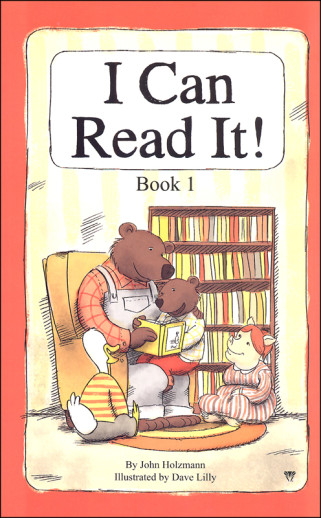We use cookies to make your experience better. To comply with the new e-Privacy directive, we need to ask for your consent to set the cookies. Learn more.
I Can Read It! Book 1
Book 1 contains 9 lessons and 45 stories that follow the sequence found in Word Lists.
Programs in this section focus primarily on teaching children to read, and may not provide comprehensive instruction in reading comprehension, spelling, writing, or other language skills. Arranged roughly by grade.
If you're serious about teaching your child to read but you don't want the process to be TOO serious (or expensive), this program might be just what you're looking for. Yes, it is a phonics program, but it's a phonics program that never loses sight of the goal: reading, and joyfully reading at that! Isn't that what you would expect from the man (John Holzmann) whose wife (Sarita) has designed a complete curriculum around joyful reading (Sonlight)? Mr. Holzmann provides an uncomplicated, yet comprehensive phonics-based program that has at its heart books of stories that your child (and you) will want to read. I can almost hear your disbelief but trust me. Who wouldn't want to read a story about two rooster dads, one with four girl chicks and one with six boy chicks, who like to cook and eat ribs (of all things!)? I found myself laughing at the ridiculousness of it all. But then maybe it was the full-color, engaging illustrations that really won my heart (think five little chicks on each side of a picnic table).
The educational premise of the program is quite simple: introduce a word list, learn a few sight words (maybe), and read stories - with the emphasis on reading the stories, and probably more than once. In fact, the author suggests that you read after and/or before your child reads so that the experience of sounding out words is coupled with hearing the appropriate voice inflection and fluency to facilitate understanding. Word lists, and their accompanying stories, are organized according to traditional basic phonics word families: short vowels, beginning and ending blends, consonant and vowel digraphs (two letters that make a single sound), syllabication, three-letter word families, special vowel combinations, hard and soft sounds, and silent letters. Sometimes there are surprises in terms of order. For instance, words ending in a vocalized s (/z/) appear in the 5th word list. Sight words are listed and learned with stories from the beginning even if the word will be part of a later word list pattern. You can spend time reading through the word lists after introducing the pattern before each story - or not - depending on the needs/preferences of your child.
The organizational structure of the program is provided in the Word Lists book which contains 68 lessons (i.e. word lists). A word list may cover one or two phonics patterns, while more difficult patterns may be spread out over multiple lessons. Everything you need to know about teaching reading is covered in seven introductory pages. Here the emphasis is on reading, simplicity, just-enough phonics, having fun and - reading. If you think this all sounds like it has been influenced by Dr. Ruth Beechick and her common sense approach to learning to read, you would be correct. A short section on spelling rules follows the word lists. Appendices include an article and table on linguistics and sound formation plus a list of the most common words in the English language.
Book 1 (9 lessons, 45 stories), Book 2 (7 lessons, 35 stories), and Book 3 (8 lessons, 40 stories) provide the stories that deliver such a delightful introduction to reading. If your math is as good as mine, you have probably noticed that there are more word lists than there are lessons with stories. Curiously, the author does not address this discrepancy. My best guess is that you are to continue learning the word lists as you broaden and expand your reading. These four little paperback books (each about 90 pgs or so) ARE the I Can Read It! program. I like to think of "complete" reading programs as having three components: systematic phonics, reading practice, and reinforcement. This program is very strong on the reading practice portion without slighting the systematic phonics. However, there is no included reinforcement. Instead, the program relies on repetition and application (the reading portion) to reinforce the systematic phonics. It's an effective plan. With its affordable price point, its emphasis on simplicity, and its encouragement to get down to the business of reading, it's the perfect program for reading families - particularly those with a Charlotte Mason or Ruth Beechick bent - that want to produce reading children. ~ Janice
| Product Format: | Softcover Book |
|---|---|
| Brand: | Avyx |
| Author: | John Holzmann |
| Grades: | PK-2 |
| ISBN: | 9781887840491 |
| Length in Inches: | 8.5 |
| Width in Inches: | 5.5 |
| Height in Inches: | 0.5 |
| Weight in Pounds: | 0.3 |

